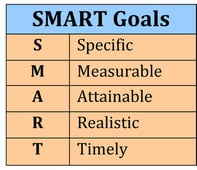How are those goals coming along? Setting a goal is about making changes, looking at what is -- in the here and now -- and what we want it to be. Creating and committing to the path to get there is what makes for the challenge. Regularly evaluating progress can keep us on that path or indicate a change of direction is needed.
By now, most of us have heard about how to develop SMART goals.(1,2) We’ve probably set them for ourselves and helped our personal training clients make them as well. But how do you know when it’s time to  review goal progress (without it becoming a neurotic disposition)? When do you kill or modify a goal? Was it smashed too early, was there a set back, or is it right on target?
review goal progress (without it becoming a neurotic disposition)? When do you kill or modify a goal? Was it smashed too early, was there a set back, or is it right on target?
Regularly reevaluating goals helps provide a gauge toward the progress being made. These goal check-ins are also a way to determine if an adjustment needs to be made in order to reach those goals. It's also important to realize and communicate that these adjustments are a normal part of the process.(2) Adjustments can include decreasing or increasing the expectations or extending a timeline, neither of which should be seen as sign of failure.
How often should you evaluate goal progress? That depends. Here are some points to consider as you determine an appropriate evaluation schedule for the individuals you are training and if the path that was initially chosen needs to change direction.
Goal Proximity
What is the timeline for achieving the goal? A longer timeline could mean that evaluations are spaced at longer intervals, where as a shorter timeline would need closer gaps. Is that time component fast approaching but the goal achievement is lacking? Is it just a temporary setback, such as work demands, increased travel, illness, injury or other issue? For many, when under performing against their goal, motivation declines.(2) Resetting the goal can help keep clients motivated rather than feeling defeated and giving up. Adding in short-term goals and milestones can further enhance motivation and results.
Scale Weight
For clients wanting to lose weight, daily weigh ins may improve their success.(3) This monitoring could prompt their day’s eating and activity behaviors. One thing to remember is that it is normal for body weight to fluctuate by 5 pounds in a single day. For tracking client progress, consider a weekly or bi-weekly weigh in. For most weight loss clients, a weekly goal of losing 0.5 to 2 pounds per week is safe and realistic.(1) Clients might eventually find that the scale number may not be as important as the body composition or other changes that are occurring. If this is the case, this is a great opportunity to consider revising the goal if the relevancy is no longer applicable.
Body Composition
As we’ve said, how often depends on the goals. About every 4 weeks could be a reasonable target for reassessing body composition. Consider that if they are losing less than 2 pounds a week, the percentage change won’t be that noticeable with shorter time frames. And if increasing lean muscle is the goal, only about 0.25 to 0.5 a pound a week is realistic gain, so once again, results are not that noticeable over shorter assessment durations. Compound that with the standard error of estimates for body composition methods of +/- 2.5% to +/- 4% with the more common and accessible methods and changes could be even less noticeable with closely spaced assessments.
Strength In Numbers
Most clients, overall, aren’t initially seeking to improve their max strength loads. Instead, tracking a client’s incremental strength improvements over each session can be a source for positive feedback via a quick motivating comment. Compare where they were when they started their training and how much more (weight, reps, or time) they can do now. How much and how quickly they improve their strength will be impacted by how much time and effort they are putting into their training. As with the other assessments and variables discussed, a minimum of 4 weeks for more formal reassessments might be a timeline to consider. You can also use strength performance tests individually in a workout rather than just in a dedicated evaluation session. Why not use the Push-up Test or the Shark Skill Test as part of the workout?
Save the Date
Have you discussed an evaluation schedule with your client? Nobody likes a pop-quiz if they aren’t prepared, and clients probably won’t enjoy a pop evaluation either. Set a schedule that is agreeable. Perhaps a special event is planned (wedding, wine tour, or some other calorie-dense occurrence), so a bit of extra “recovery” time is needed if weight loss is a goal. They'll still want to enjoy the event, in moderation, while understanding this might extend their goal achievement timeline.
These were just a few things to consider as you plan your clients training and assessment schedule. As you can see, there are not hard “rules” on when to perform follow up assessments for most clients with general fitness goals. Each training session offers an informal opportunity to remind them of their goal(s) and check-in on their progress, while also exploring any barriers that are hindering results or may require additional review.(2) Try to keep the evaluations a positive and motivating experience. For more information and ways to help your clients keep committed to their goals, check out the NASM Behavior Change Specialization!
References:
- McGill E., Montel, I. (2017) NASM Essentials of Personal Fitness Training (5th ed.). Burlington, MA: Jones & Bartlett Learning.
- NASM Behavior Change Specialist manual. Chandler, AZ: National Academy of Sports Medicine.
- Steinberg, D.M., et al;. “Weighing every day matters: daily weighing improves weight loss and adoption of weight control behaviors.” Journal of the Academy of Nutrition and Dietetics, 115, NO. 4 (APR 2015): 511-18.
















